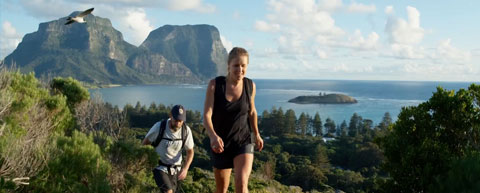Top 20 Soul-Stirring Moments on the Great Walks of Australia
The Real Magic Behind the Tracks and Trails
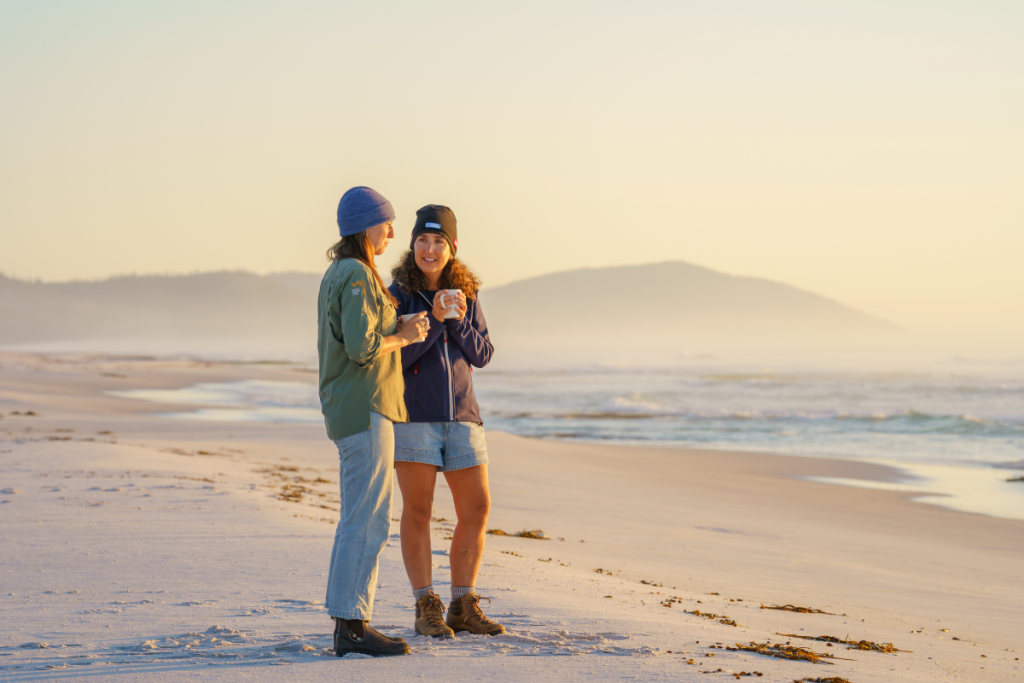
If you ask someone what draws them to Australia’s famous walking trails, the answer usually starts with the landscapes: ancient peaks, endless beaches, red deserts, forests rich with scent and silence. These are the scenes you see in the brochures. Yet talk to any walker, months or years after their journey, and you’ll hear stories of something deeper. The small, unexpected moments that shift the soul and become the beating heart of the adventure.
This blog lifts the lid on the real moments that define a multi-day guided walk across Australia’s extraordinary terrain. It’s not the muscle-burn of a tough ascent or the postcard view at the summit. It’s the quiet, unexpected, and profoundly human experiences that linger long after your boots are packed away.
Quick Summary
- The most powerful moments are often the quietest: sunrise stillness, shared stories, chance wildlife sightings.
- Connection with nature, guides, fellow walkers, and yourself. This defines these journeys.
- Sensory details (smells, sounds, touch) are as memorable as the views.
- Local culture, expert guidance, and thoughtful care deepen the experience.
- The emotional payoff: pride, awe, calm, joy, and a sense of belonging.
Let’s walk through the top twenty moments that walkers remember most.
- The Hush of Dawn Before the Birds Begin
There’s a deep, grounding stillness on the trail just before sunrise. A sense that nature is holding its breath with you, waiting for the first birdsong. - The First Brew in the Crisp Morning Air
Imagine wrapping cold fingers around a steaming mug, brewed by your guide as the day’s anticipation builds. It’s a small ritual, yet sets the emotional tone: you’re cared for, and the day’s possibilities are wide open. - When a Guide Shares a Story That Changes Everything
A single story about the land’s cultural heritage, ecology, or geology can be transformative. Suddenly, the rocks and trees tell their own tales, and the ground beneath your feet feels more alive. - The Moment Your Legs Find Their Rhythm
After the initial push, there’s a gentle settling in your stride. Breath, pace, and mind all in sync. It’s grounding and calming, a physical meditation. - Light Moving Across the Landscape at Sunrise
Watching ridges, coastlines, or desert plains reveal themselves layer by layer as light shifts. It’s a slow, quiet spectacle, and it feels like a reward for waking early. - A Wildlife Encounter That Feels Like a Blessing
A joey peeks from a pouch, a line of emu chicks follows their father, an echidna shuffles across the track. These are rare gifts, moments of pure wonder. - Turning a Corner to a Surprise Picnic
A secluded beach, a quiet forest clearing, a hilltop with a view and a picnic spot waiting. Delight, gratitude, and a sense that someone is looking out for you. - Realising You Haven’t Checked Your Phone
There’s a rare joy in the clarity that comes when you forget about notifications and simply walk, present in the moment and place. - Conversations That Flow Easily and Sincerely
Stories you’d never hear anywhere else. Strangers becoming friends through the shared rhythm of the trail. - Reaching a Lookout to a Warm Snack or Drink
That small gesture. A guide handing you a hot drink or snack at a windswept lookout. It feels wonderfully big after a good walk. - The Smell of Eucalyptus After Rain
A scent that hits with nostalgia, clarity, and awe. It’s pure Australia, and it lingers long after the walk is over. - Watching the Landscape Change in a Single Day
Forest to coastline, gorge to plateau, rainforest to open plain. It feels like you’ve visited several worlds in one walk. - Seeing Where You Walked Earlier That Day
Glancing back and spotting a distant ridge or bay you crossed earlier. It’s pride, perspective, and the thrill of progress. - Arriving to the Warm Glow of Your Lodge or Hut
After hours on the trail, that first glimpse of warm light. Delightful comfort, care, and a sense of arrival. - Sitting Down to Chef-Inspired Dishes
Local produce, native flavours, paired wines, laughter around the table. Meals become rituals, highlights in themselves. - A Sky Full of Stars Without Light Pollution
The Milky Way arches overhead, impossibly clear. Many walkers have never seen a sky like this before. - Hearing the Ocean Long Before You See It
The sound pulls you forward with anticipation, heart beating a little faster. - When a Guide Points Out a Hidden Detail
A rare wildflower, a tiny bird, a secret track marker, a cultural site you’d have missed. Expertise turns to magic. - Feeling Genuinely Cared For
From tips for packing to anticipating your needs, the thoughtfulness of your guides creates a deep, rare sense of ease and immense gratitude. - The Quiet Moment Before Sleep
Muscles tired in the best way, heart full, mind clear. This is a rare contentment that’s hard to find anywhere else.
Why These Moments Matter
Yes, the views on the Great Walks of Australia journeys are absolutely extraordinary. And what truly stays with walkers are these small, human, and heartfelt moments, woven through each day by the rhythm of nature, the skill and care of your guides, and the freedom to be present in a remarkable place. These aren’t just walks. They’re living, breathing stories that you carry home, stitched together by joy, wonder, and real connection.
Ready to Find Your Walk?
If you’re curious which trail or track might speak to your spirit, our expert walking operators can help you find the right adventure. Whether you crave wild coasts, ancient ranges, or slow, sensory discovery, each journey is made of many steps, yet it’s these moments that define it.
Whether you’re new to walking holidays or a seasoned hiker, there’s a track with your name on it. Browse the full Great Walks of Australia collection and find the route that calls you, and if you’re still not sure where to start, sign up for our eNews for regular updates, practical tips, and stories from the trails or enquire here with any questions or queries you may have.
FAQ
What’s the best time of year for Great Walks in Australia?
It depends on the region. We provide year-round walking opportunities. Coastal trails are stunning in spring and autumn, while some inland walks are best in the cooler months. Always check with the operator for seasonal tips and find out more on walking seasons across Australia here.
Are these walks suitable for first-time multi-day walkers?
Absolutely. Most guided walks cater to a range of fitness levels and offer support, comfort, and expert guidance. Let the team know your experience level when enquiring or at time of booking.
What should I pack for a multi-day walk?
Essentials include sturdy boots, weather-appropriate layers, a good rain jacket, hat, sunscreen, and a sense of curiosity. Most walks provide a detailed packing list.
How much wildlife might I see?
Encounters vary, and of course are not 100% guaranteed, however walkers often spot kangaroos, wallabies, echidnas, emus, and wide and varied range of birdlife. Guides know where to look and how to maximise your chances of respectful viewing.
What’s included in a guided multi-day walk?
Most Great Walks of Australia packages include unique accommodation, meals, snacks and expert guiding. Check the specific walk for details for more information on beverages, transfers if and when appropriate, luggage requirements and optional extra’s that may be available at an additional cost for massage or other spa related treatments.
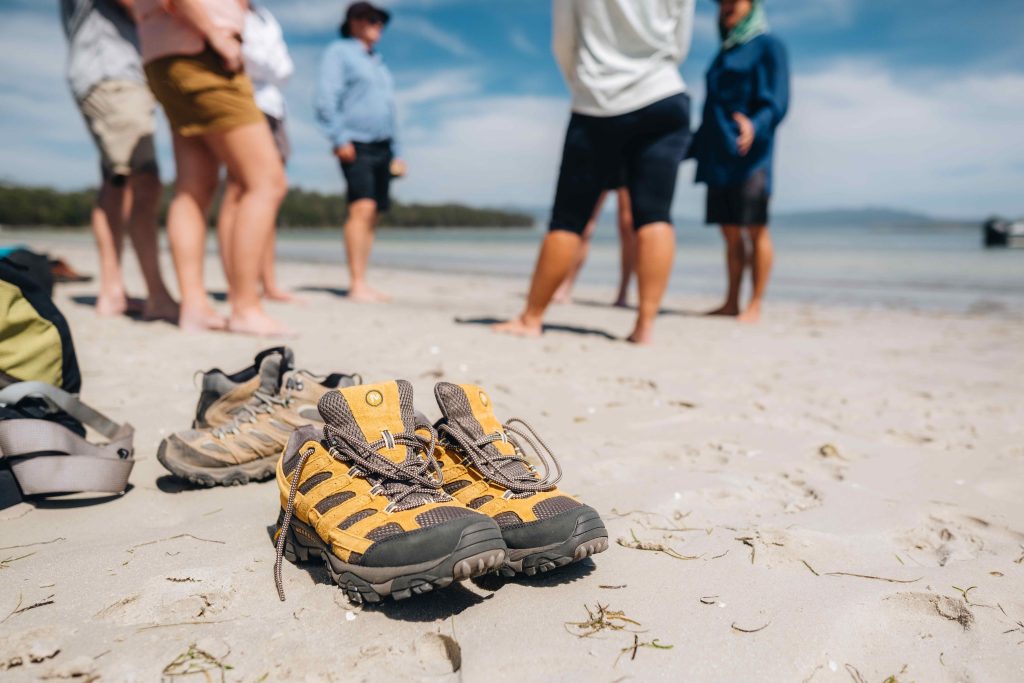
There’s a particular kind of anticipation that settles in once you’ve decided to take on one of Australia’s Great Walks. It starts as a flutter of excitement. Maybe you’re picturing yourself tracing a winding path through eucalyptus, feeling the weight of your pack, or catching the scent of rain on cool earth. If you’re at the dreaming stage, you’re not alone; many hikers find themselves clicking through photos, imagining their boots crunching through gravel, long before any real planning begins.
What follows is a gentle invitation. Not just to conquer kilometres, but to truly feel every moment on the trail. Preparing for a Great Walk of Australia isn’t only about physical fitness or gear checklists, it’s about tuning into the quiet joy of anticipation, picturing yourself in a landscape that’s both exhilarating and grounding, and making choices that let you savour the experience from the first training walk to the last shared meal under the stars.
Summary
- Preparing early transforms the walk from a challenge to a deeply rewarding experience.
- Building trail fitness adds to your enjoyment and reduces the risk of injury.
- The right gear, especially comfortable, well-fitted boots – makes all the difference.
- Sensory details, like the smells and sounds of the trail, are as important as the views.
- Local tips and gradual, mindful prep build confidence and deepen your connection to the journey.
Building Your Trail Fitness: Slow, Steady, and Sensory
Most Great Walks of Australia stretch over 10 to 15 kilometres a day, often across terrain that changes as quickly as the weather. Imagine the crunch of gravel underfoot, a sudden chill when clouds gather, or muscles warming as you climb a sun-dappled ridge. The experience is richer when your body is ready for it.
Start three months out, if you can. Begin with short walks, letting your legs remember the rhythm of steady movement. Add hills, feeling your breath deepen and your stride adjust as the gradient shifts. If your walk involves carrying your gear, fill your pack and test it on longer routes; listen to what your shoulders and back tell you. Aerobic exercise whether running, cycling, swimming – these all build stamina, however it’s the gradual layering of distance and hills that prepares both mind and body for the journey.
Consider adding yoga or pilates. These sessions aren’t just for limber muscles, but for the quiet sense of balance and focus that stays with you when you’re on the trail and the world narrows to the sound of your own breathing.
Gear that Works: Comfort, Familiarity, and Trust
When you’re walking for hours, your gear becomes part of you. The right pack sits easily on your shoulders. A rain jacket (well chosen) keeps you dry without turning every step into a furnace. Simple checks make a difference: are the zips working? Is your rain cover easy to grab in a hurry? For most Great Walks, essentials like packs and raincoats are provided, however if you have a favourite piece of equipment that’s weathered other adventures with you, that familiarity brings quiet reassurance.
Boots are non-negotiable. Choose comfort and support over looks or trends. Shop in person, if you can. Try them on slopes, walk around the store until you forget you’re not already on the track. Break them in over several weeks. Blisters and aching arches don’t need to be part of your story. Before you set out, check for signs of wear: aging glue or tired soles can unravel your plans as quickly as a surprise storm.
Poles are optional, but if you think you might use them, carry them on your longer practice walks. That way, they’ll feel like an extension of your movements, not an afterthought.
Where to Find the Right Gear
While brands like Scarpa, Merrell, and Keen are popular, the most important thing is fit. National retailers such as Paddy Pallin, Mac Pac, Anaconda, and Kathmandu offer a good range, and local stores like Mountain Equipment (NSW), Bogong (VIC), or Find Your Feet (Tasmania) know the local trails and conditions. The staff there are often hikers themselves and their advice is rarely just theoretical but incredibly practical.
The Emotional Prep: Daydreams, Doubts, and Small Rituals
Preparing for a Great Walk isn’t just about ticking boxes. It’s about letting yourself lean into the anticipation. Spend time on the Great Walks of Australia website, letting your imagination wander through the different landscapes. Picture yourself pausing on a ridgeline, wind tugging at your hat, or sharing a quiet moment with new friends as the sun dips behind distant peaks.
Allow space for nerves or doubts as they’re a normal part of the process. Every confident walker you see has felt them. The gentle chafing of a loaded pack on your first long walk, the surprise of discovering a muscle, two or a few that you never knew you had (or had perhaps forgotten about), these are reminders that you’re preparing not just your body, but your spirit.
If you need a nudge, make a call to your chosen Walk Operator – they all have planning guides for each of their walks. Sometimes having a simple, practical checklist in hand (or sitting on the fridge) is all it takes to turn uncertainty into a quiet sense of readiness.
The Small Moments That Stay With You
Ask seasoned walkers what they remember most and it’s rarely just the summit views. It’s the smell of baking bread drifting from a town as you pass through, the way your pack feels lighter after lunch, or the laughter that bubbles up when someone slips in the mud and everyone helps brush them off. These moments rarely make it into the glossy brochures, yet they are what define a walk as meaningful and memorable for many years to come.
FAQs
How far should I train before my Great Walk?
Aim for at least one 10km walk per week in the months leading up to your trip, mixing in hills and carrying your pack if you’ll be doing so on the walk itself.
What gear is essential for the Great Walks of Australia?
A three-layer waterproof rain jacket, a comfortable daypack or overnight pack, and well-fitted boots are key. Check supplied gear lists and make sure your equipment is in good working order.
How do I break in new hiking boots?
Start wearing them on short walks, gradually increasing distance. Make sure to walk on different surfaces and tackle some hills to check for fit issues.
Where can I get fitted for hiking boots in Australia?
Specialist outdoor stores like Paddy Pallin, Mac Pac, Anaconda, and local outfitters such as Bogong or Find Your Feet offer professional fitting and advice.
Do I need walking poles?
Poles are optional; some find them helpful for stability on uneven ground or descents. If you haven’t used them before, try them out on training walks to see if they suit your style.
P.S If you’re ready to turn daydreams into real footsteps, request your Planning Guide here to lock in the ideal Great Walk of Australia that suits you. Start your journey with quiet confidence, knowing every step is part of something extraordinary.
Discover the Newest Signature Walks in Australia’s Iconic Collection of Premium Multi-Day Guided Hiking Experiences.
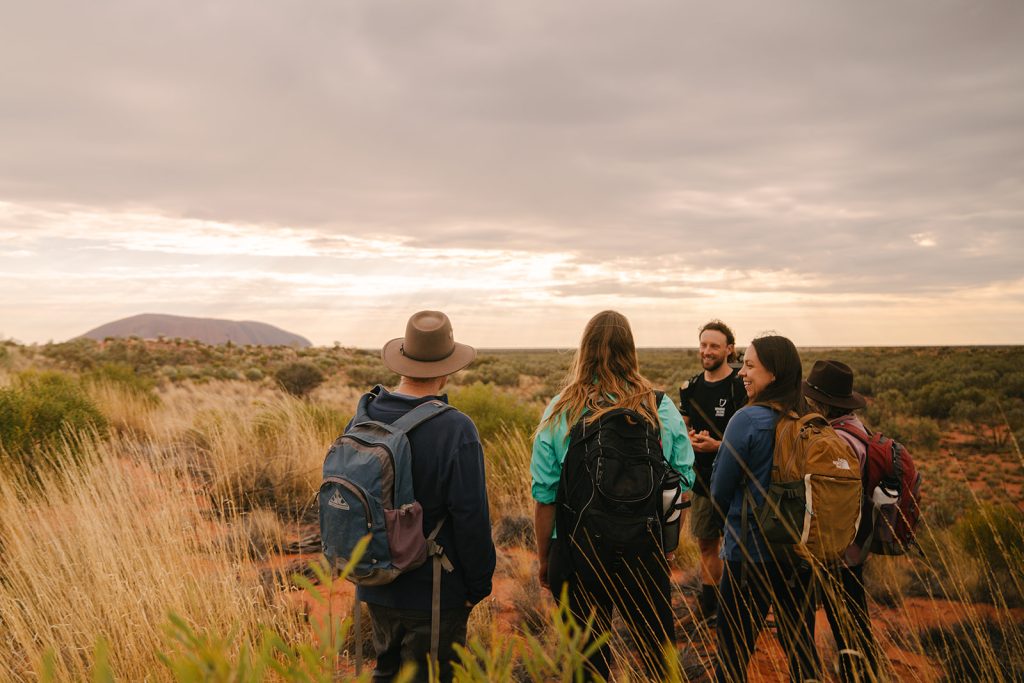
Today marks an exciting day for passionate walkers and nature lovers: Great Walks of Australia proudly welcomes two brand new experiences to Tourism Australia’s Signature Experiences collective. The Uluṟu–Kata Tjuṯa Signature Walk and the Kangaroo Island Signature Walk. If you’ve been dreaming of your next journey into Australia’s wild, breathtaking heart, these world-class, guided walks promise connection, immersion, and a new benchmark for sustainable travel.
In a hurry? Here’s what’s new:
- Two new Signature Walks: Uluṟu–Kata Tjuṯa (NT) & Kangaroo Island (SA), both operated by Tasmanian Walking Company
- All-inclusive, fully guided, multi-day adventures: Comfort, safety, and deep cultural & natural immersion
- Exclusive access: Uluṟu–Kata Tjuṯa Signature Walk is the only walk offering overnight stays inside the National Park
- Small group journeys: Maximum 14–16 guests per walk
- Sustainable, premium experiences: Carbon neutral, eco-certified, chef-inspired and guide-prepared meals, and unique accommodations
Why These Walks Matter
If you’ve explored one of our existing Great Walks of Australia, you will know these aren’t “just” hikes. They’re curated journeys shaped by story, landscape, and shared experience. With these new additions, the collection now offers 15 of the country’s most remarkable, premium nature-based adventures.
Genevieve Matthews, Executive Officer of Great Walks of Australia, captures the spirit of this expansion:
“Uluṟu–Kata Tjuṯa and Kangaroo Island Signature Walks offer guests an extraordinary combination of nature immersion, expert guides, comfort, culture, and storytelling, which defines what makes a Great Walk of Australia truly great. These walks add both heart and a new edge to our collection.”
Spotlight: Uluṟu–Kata Tjuṯa Signature Walk
Five Days, Four Nights | 54km | Max 16 Guests | From $5,395pp
If you’ve ever felt the pull of the Red Centre, this is your invitation to walk deeper. Developed in partnership with Aṉangu Traditional Owners, the Uluṟu-Kata Tjuṯa Signature Walk is the first and only multi-day experience offering exclusive overnight stays inside the National Park itself.
- Access: Yulara (Ayers Rock Airport)
- Season: April–September
- Accommodation: Eco-camps and private lodge, inside the National Park
- Highlights:
- Guided in partnership with Aṉangu Traditional Owners and expert storytellers
- Chef-inspired meals under star-filled skies
- Optional wellness therapies
- Deep cultural workshops and connection to Country
- Small groups, carrying only a day pack
- End each day with desert sunrises, ancient geology, and moving stories
Brett Godfrey, Co-Owner of Tasmanian Walking Company, describes it best:
“A decade in development, but 500 million years in the making, the Uluṟu-Kata Tjuṯa Signature Walk is a five-day, fully guided, premium hiking experience inside Uluṟu-Kata Tjuṯa National Park that was developed in partnership with Aṉangu Traditional Owners. Guided by both indigenous partnership and a culture more than 40,000 years old, it has been a long-held dream to be granted overnight access within the World Heritage-listed National Park. Our guests will journey across Country, staying in our new flagship, environmentally sensitive, high-quality private camps and lodge. It’s an experience that unites comfort with a genuine connection to the heart of Australia.” Mr Godfrey said.
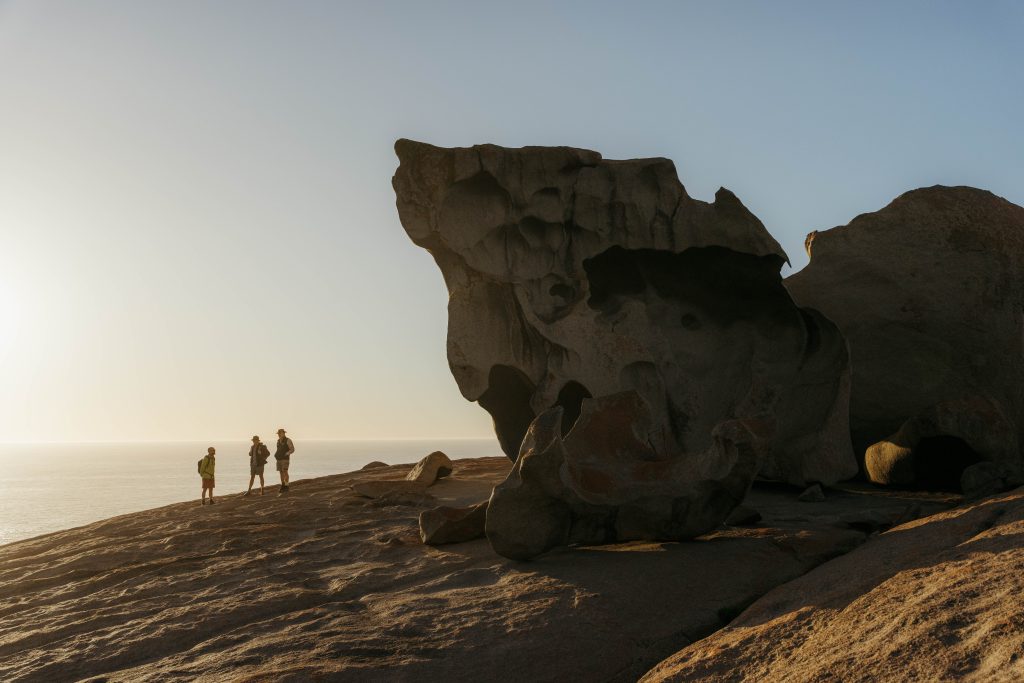
Spotlight: Kangaroo Island Signature Walk
Four Days, Three Nights | 46km | Max 14 Guests | From $2,995pp
Few places on earth feel as alive, and as untamed – as Kangaroo Island. This four-day, fully guided adventure reveals the island’s most spectacular corners, from lush rainforest and wild bushland to the dramatic coastal cliffs and geological icons like Admirals Arch and Remarkable Rocks.
- Access: Return transfers from Adelaide (including ferry)
- Season: September–December, February–May
- Accommodation: Heritage-listed Cape du Couedic Lightkeeper Cottages (built 1907)
- Features:
- Follow the Kangaroo Island Wilderness Trail in Flinders Chase National Park
- Encounter sea lions, wallabies, echidnas, rare birds
- Chef-prepared meals with local produce, paired with premium South Australian wines
- 100% carbon neutral, Advanced Ecotourism Australia certified
- Extra touches: use of backpack, weatherproof jacket, small group support
As Mr. Godfrey shares:
“The Island is back! Kangaroo Island Signature Walk invites guests to explore the wild beauty of Kangaroo Island on a four-day guided journey combining rugged coastal cliffs, pristine bushland, and abundant native wildlife. This all-inclusive experience features heritage lighthouse accommodation, chef-prepared meals, and expert guides who bring the island to life.”
A New Chapter for Australian Walking
Robin Mack, Acting Manager Director, Tourism Australia said today’s announcement strengthens the world-class nature-based tourism offering Great Walks of Australia represents.
“Great Walks of Australia is a collection of safe, all-inclusive, multi-day hiking experiences that allows visitors to be immersed in the country’s most spectacular landscapes and wilderness areas. Kangaroo Island Signature Walk and Uluṟu-Kata Tjuṯa Signature Walk provide both domestic and international tourists with an invitation to deeply connect with nature, culture and place. ” Mr Mack said.
The New Walks At a Glance
| Walk | Duration | Distance | Group Size | Price (from) | Season | Accom |
|---|---|---|---|---|---|---|
| Uluṟu–Kata Tjuṯa | 5 days / 4 nights | 54km | 16 | $5,395pp | Apr–Sep | Private eco-camp & lodge |
| Kangaroo Island | 4 days / 3 nights | 46km | 14 | $2,995pp | Sep–Dec, Feb–May | Heritage light- house cottages |
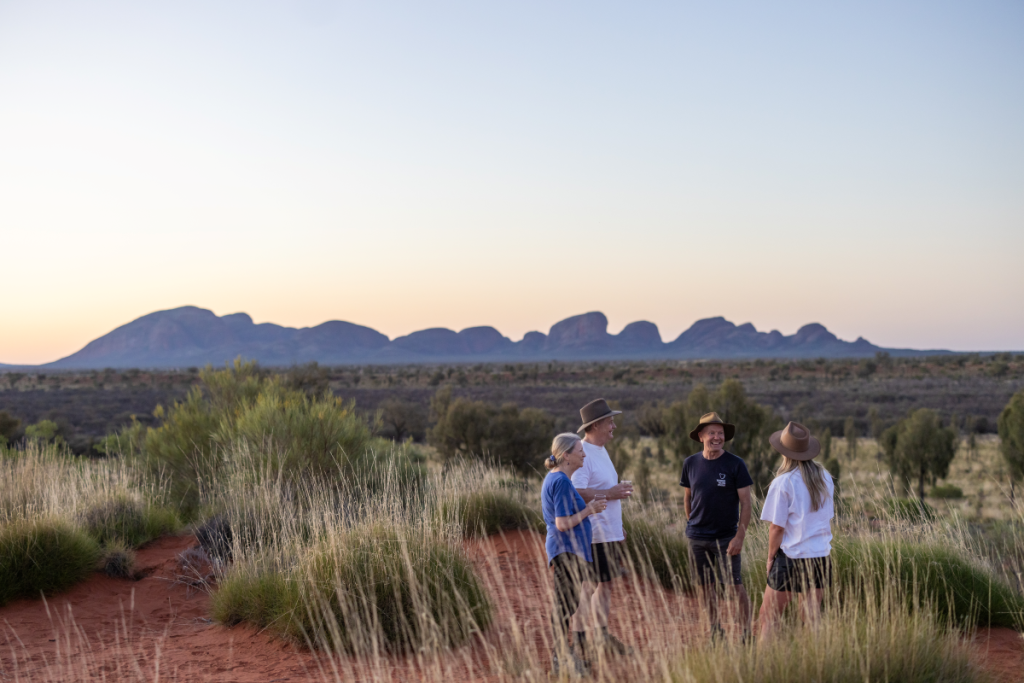
FAQ
How do I book a place on these walks?
Both walks are available through Great Walks of Australia’s website or via Tasmanian Walking Company.
What fitness level is required?
Both walks are rated moderate, suitable for walkers with a reasonable level of fitness.
Are the walks all-inclusive?
Yes. All meals, drinks, accommodation, expert guides, transfers, park fees, and selected gear are included.
Are there solo or single supplement options?
Yes, single supplements are available.
How are these walks different from others in the collection?
Uluṟu–Kata Tjuṯa Signature Walk, is the only walk offering exclusive overnight stays inside the National Park with deep cultural immersion. Kangaroo Island Signature Walk offers heritage accommodation, chef-inspired meals, and one of Australia’s most wildlife-rich landscapes.
Where can I learn more or see photos?
Visit greatwalksofaustralia.com.au/our-walks for details, images, and booking info.
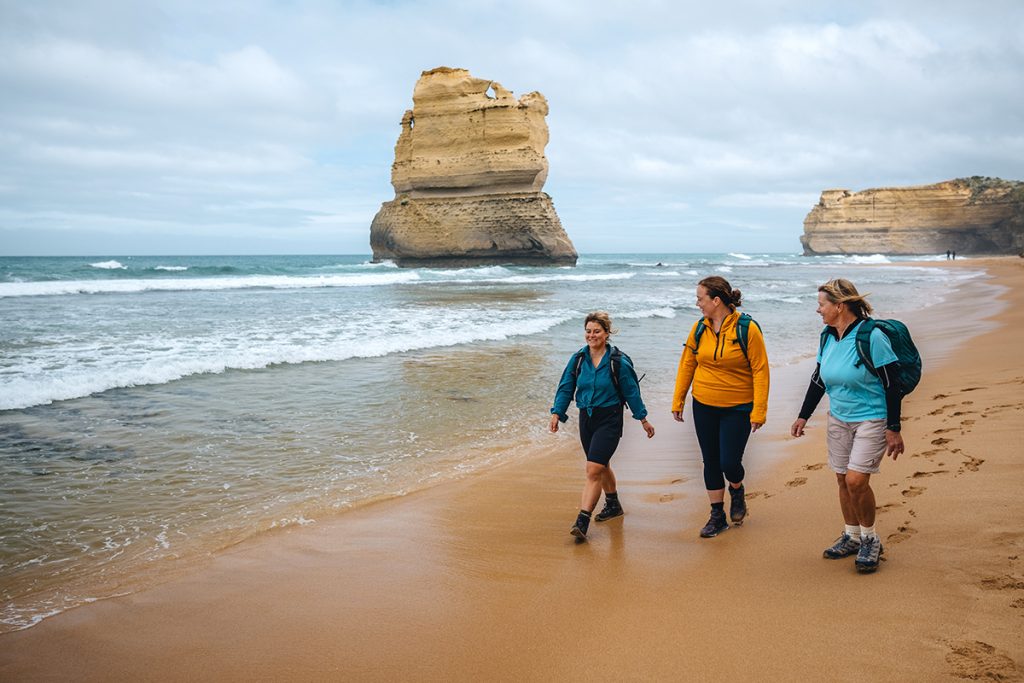
Why More Travellers Are Rethinking Wellness—And How a Walk Can Make a Difference
For years, “wellness” has meant different things to different people. For some, it’s a morning yoga class or a green smoothie. For others, it’s the quiet joy of losing yourself in a good book, or the sense of accomplishment after reaching the summit of a mountain. However, as we recognise World Mental Health Day today, it’s timely to ask:
What does wellness truly mean for me? Does it live in grand gestures, or in the steady, nurturing rituals we bring into our everyday lives?
Wellness rarely arrives in a single, life-changing moment. More often, it’s found in the choices we quietly make for ourselves — like deciding to take on a multi-day walk. And here’s the real gift: the journey begins long before your boots touch the trail.
Choosing a walk isn’t just about the hike itself. It’s the days and weeks leading up to it: carving out time to train, preparing your gear, planning your route, and quietly building confidence in your own abilities. Each small step — an early morning walk, a new pair of socks, a call with a walking buddy — is a gentle act of self-care.
By the time you set foot on the trail, you’ve already nurtured your wellbeing in so many subtle, important ways.
Quick Summary
- Wellness is personal. Preparing for a walk is a process that builds resilience and confidence, not just fitness.
- Walking holidays offer unique, proven benefits for mental health, including calm, connection, and a sense of daily accomplishment.
- Science backs it up: Time in nature, especially over multiple days, supports lower anxiety and brighter moods.
- Multi-day walks invite travellers to slow down, let go, and return to life feeling more themselves.
- Real stories from the track show it’s often the preparation and small moments that matter most.
Wellness: More Than a Buzzword
Wellness is everywhere these days. Smoothie bars, apps, and yoga studios promising the secret to happiness. The Oxford Dictionary calls it “the state of being in good health, especially as an actively pursued goal.” But talk to someone who has returned from a multi-day walk, and you’ll hear a more personal story.
For many, wellness is the feeling that you’re enough – not perfect, not constantly striving, just gently tuning in to what you need. It’s a blend of movement and stillness, challenge and comfort, solitude and connection. And it’s most powerful when it’s woven into the rhythms of everyday life.
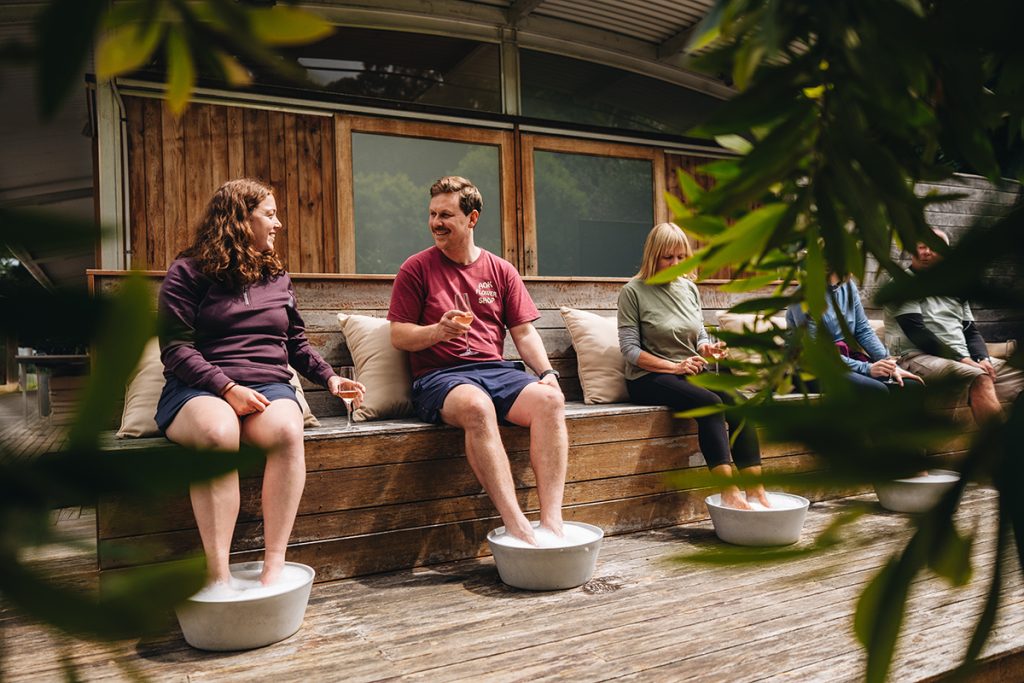
The Science: Why Walking in Nature Lifts Your Mood
If you’ve ever noticed your worries soften after time outdoors, science says you’re onto something. Research in Frontiers in Psychology and other journals has shown that walking in nature can:
- Lower stress hormones (like cortisol)
- Improve sleep
- Reduce feelings of anxiety and depression
- Spark creative thinking and fresh perspectives
Stanford University researchers even found that time in wild places can help break the exhausting loop of repetitive, negative thoughts (the kind that love to stick around on tough days). And the benefits grow stronger the longer you give yourself to disconnect and just walk.
It Starts Before You Set Out: The Quiet Power of Preparation
Committing to a multi-day walk is a quiet promise you make to yourself: I will invest in my wellbeing. The steps you take, from researching the right boots to learning what snacks keep you going. These are small victories.
You might notice:
- The satisfaction of feeling fitter as the weeks go by
- The comfort of a well-packed backpack, ready and waiting
- The excitement that builds with every plan and every “what if?”
This gentle lead-up builds inner strength and self-trust. It’s not about chasing perfection. It’s about showing yourself steady care.
On the Trail: Walking for Your Mind, Not Just Your Muscles
When you finally head out, the benefits only deepen. Here’s what past Great Walks of Australia travellers often share:
1. Space to Think (Or Not Think at All)
“By the second day, my thoughts slowed to the rhythm of my steps. The track became my quiet place to process, to breathe, to just be.”
2. Real Connection — With Nature, Yourself, and Others
“On the trail, I felt part of something bigger. Whether I was swapping stories over dinner or savouring a silent sunrise, I connected with parts of myself I’d lost touch with.”
3. A Gentle Sense of Achievement
“Completing each day’s walk — even through rain or tired legs — gave me a quiet pride I carried home. It reminded me that I’m stronger than I think.”
Little Moments, Lasting Impact
- The fresh scent of eucalyptus in the early morning.
- A mug of tea warming your hands after a satisfying day.
- The quiet hush of a forest, broken only by birdsong.
- The pleasure of a shared laugh with a new friend.
- That first, deep breath of ocean air after hours inland.
These aren’t luxuries. They’re reminders that real wellness is stitched together from simple, sensory moments… if we make space to notice them!
How to Get the Most from a Walking Holiday (for Mind and Mood)
- Choose a walk that lets you truly unplug
Multi-day, guided walks (like those with Great Walks of Australia) are designed for leaving daily distractions behind in safe, beautiful settings. - Don’t rush the preparation
Enjoy the process of getting ready: walking in your local park, trying out your gear, walking and talking with friends. Letting the anticipation build. - Allow for both company and solitude
Some days you’ll want to share the journey; others, you’ll crave quiet. Both are valuable. - Set kind intentions
Forget about “achievement.” Instead, focus on being present, gentle, and open. - Celebrate every step
Whether you walk 5km or 50, each day is a win for your mind as well as your body.
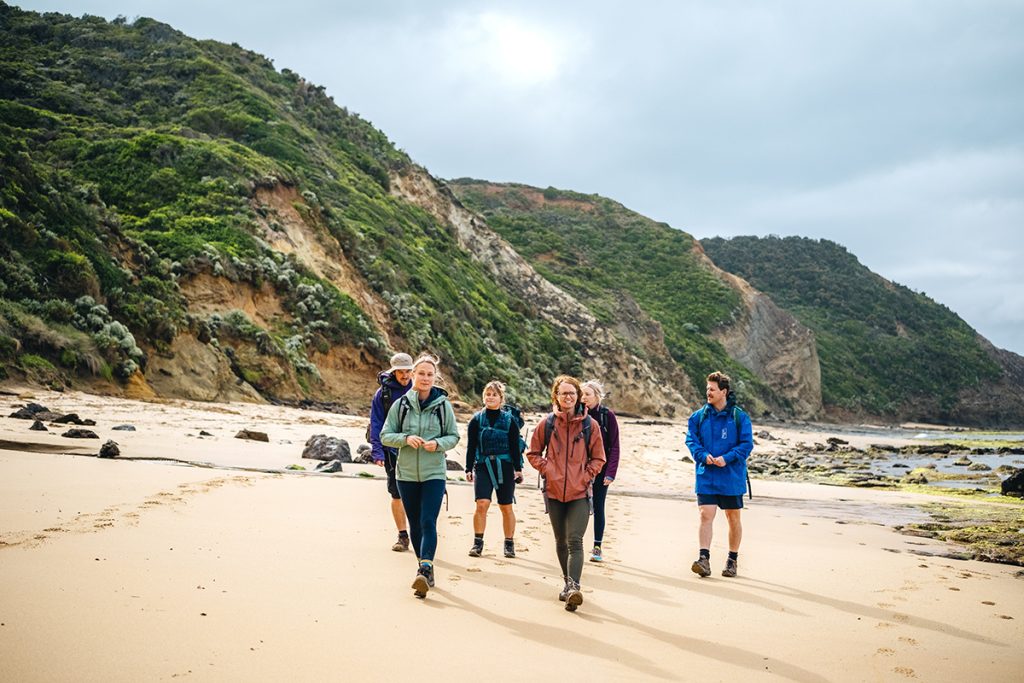
Frequently Asked Questions
Is walking really good for mental health?
Yes. Countless studies show that gentle movement in nature lowers stress, lifts mood, and encourages better sleep — especially when you can fully unplug.
Do I need to be super fit for a multi-day walk?
Not at all. Many of the Great Walks of Australia are designed for a range of abilities, with support, rest options, and expert guides to help you find your pace.
Will I come back “a new person”?
Maybe not. You will still be you, however you’ll likely come back feeling more yourself than you have in years.
How do I find the right walk?
Head over to Great Walks of Australia’s Walks page for honest descriptions, guest stories, and planning tips.
This World Mental Health Day, Take a Step for Yourself
Wellness isn’t about overhauling your life or chasing the next trend. Sometimes, it’s just about putting one foot in front of the other — and letting the journey do what it does best: restore, reconnect, and remind you how good it feels to slow down.
Ready to walk your way to wellbeing?
Images showcased here from our 4 day / 3 night Twelve Apostles Signature Walk. Marvel at the rugged Victorian coastline as you walk dedicated tracked ending in the icon Twelve Apostles. Visit our website to see which other walks from the collective call you, and start your own story of gentle, lasting care. Read more on Beating Burnout by Walking in Nature here.
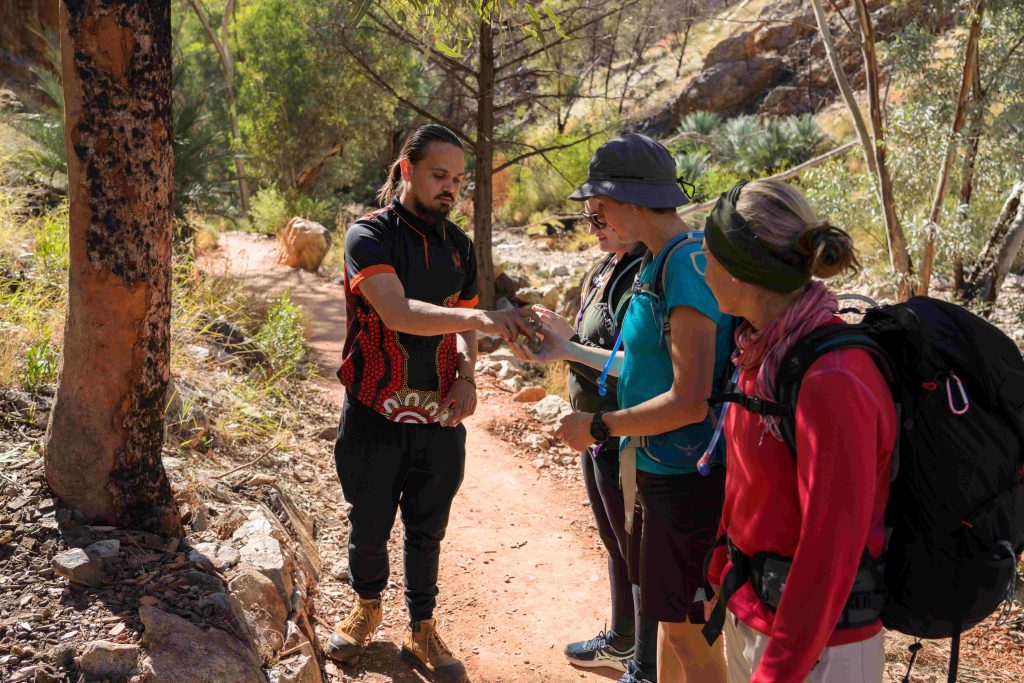
Every great journey has a story and some stories are told best by the people who’ve spent a lifetime caring for travellers and Country. As World Expeditions celebrates fifty years of guiding people gently into wild places, that deep well of trust, knowledge, and connection is more important than ever.
These aren’t just adventures. They’re a promise: you’ll be held, not hurried. Supported, not rushed. Because when a team has been quietly setting the benchmark for five decades, you feel the difference in every thoughtful detail.
Summary
- World Expeditions marks 50 years of experience, care, and leadership in adventure travel.
- In 2025, World Expeditions/Australian Walking Holidays marks 30 years on the Larapinta Trail, a symbol of deep local partnerships and pioneering comfort in the outback.
- Flinders Island Walking Adventure in Comfort, the newest Great Walk of Australia, offers a wild, grounding coastal contrast — with sustainability and comfort at its heart.
- World Expeditions recorded a 72% increase in walker numbers on Flinders Island in 2024. True to the brand’s small group philosophy – with a maximum of 12 walkers – and strong environmental focus, this growth has been achieved in a carefully managed and sustainable way, ensuring the island’s pristine landscapes remain protected for future adventurers.
- Both walks are built on respect for Country, strong community ties, and a genuine sense of place.
- Now is the time to start dreaming about your next adventure, knowing you’re guided by a team shaped by the land and its stories.
Walking With Heart: Fifty Years, Two Profound Journeys
World Expeditions’ golden anniversary is more than a milestone. It’s a testament to a philosophy that has never wavered: adventure is not about conquering landscapes, but about being welcomed into them. Their legacy is felt most clearly in the walks that have become part of Australia’s spirit.
Larapinta Trail: Thirty Years of Deep Connection
Since 1995, World Expeditions and Australian Walking Holidays have been guiding people through the soul-stirring spaces of the Larapinta Trail. This experience is a living partnership with the land and its traditional custodians. With a strong focus on Indigenous interpretation and genuine relationships with Arrernte people, every step asks travellers to slow down, listen and learn.
Australian Walking Holidays was the first to bring semi-permanent, low-impact Eco-Comfort Camps to the West MacDonnell Ranges. This was more than a practical advance; it was a statement of values. Walkers could breathe in the desert air, sleep well, and tread lightly — all while feeling a real sense of safety, ease and belonging in the heart of the Red Centre.
As World Expeditions marks thirty years on the Larapinta in 2025, their commitment to leadership, comfort and community remains as strong as ever. As CEO Sue Badyari reflects:
“We’ve spent the last five decades crafting walking experiences that respect the land, support local communities and challenge the status quo of active travel.”
Flinders Island: A Grounding, Wild New Chapter
South on the continent, Tasmanian Expeditions brings a different kind of wonder. Flinders Island, named the 13th Great Walk of Australia in 2024, offers a rugged, windswept, and deeply grounding experience. Here, granite peaks rise from the sea, wildlife moves through windswept heath, and each day ends in an exclusive Eco-Comfort Camp with the shoreline just steps away.
The Flinders Island Walking Adventure is guided, supportive, and designed for comfort with star-gazing roof tents, nourishing meals, and time to slow down and listen to the rhythms of the island. This walk is a contrast to Larapinta’s ochre heart: lush, coastal, and wild, with a deep sense of peace.
World Expeditions recorded a 72% increase in walker numbers on Flinders Island in 2024. True to the brand’s small group philosophy – with a maximum of 12 walkers – and strong environmental focus, this growth has been achieved in a carefully managed and sustainable way, ensuring the island’s pristine landscapes remain protected for future adventurers.
In the words of Tasmanian Expeditions’ General Manager:
“Flinders Island is wild, wind-swept and deeply grounding – it’s Tasmania’s best kept secret. We’re proud to have developed this walk with sustainability and comfort at its core.”
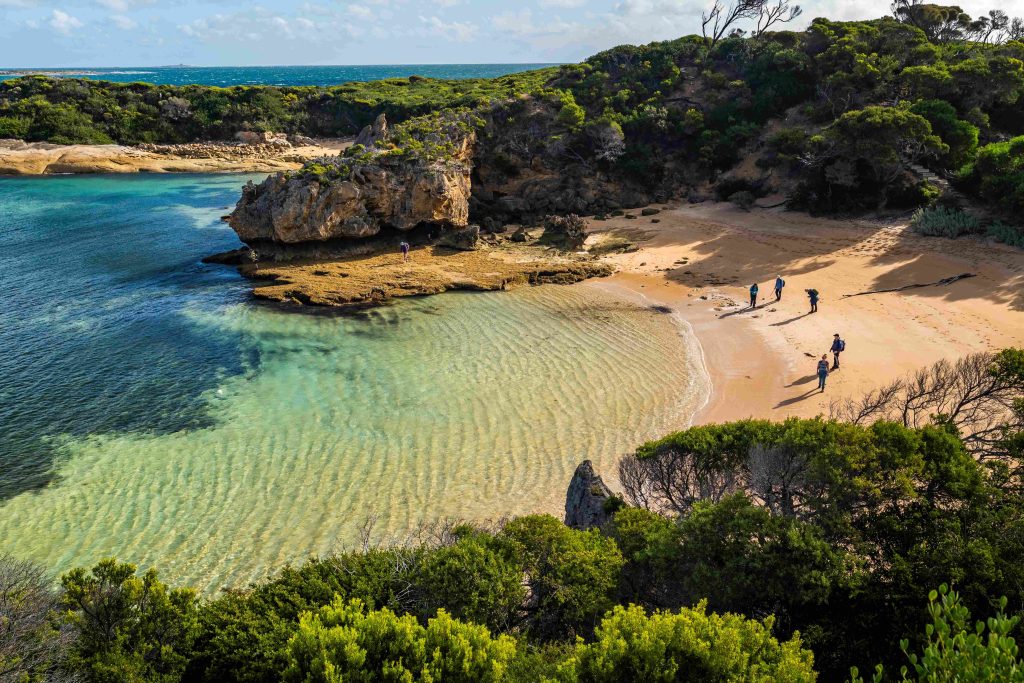
Why These Walks Matter in the World Expeditions Story
The Larapinta and Flinders Island walks are symbols. Together, they show what it means to lead with heart: to create journeys that are comfortable, immersive and respectful.
World Expeditions was the first to bring real comfort into remote, multi-day treks without ever compromising on sustainability or cultural respect. Both walks offer a strong sense of place, a feeling of belonging, and an ongoing commitment to the communities who call these landscapes home.
The experience isn’t about ticking off “great walks”—it’s about returning with a story written into you, shaped by every sunrise, every footstep or fireside chat, every moment of quiet awe.
Held by Experience, Welcomed by Community
After fifty years, World Expeditions has continued to focus on what really matters: holding travellers gently, honouring the places they visit, and always striving to do better. Whether you’re crossing a desert ridge on Larapinta or feeling the salt wind on Flinders, you know you’re part of something bigger, something special and important.
Behind every step on Larapinta or Flinders Island are the teams who bring these journeys to life. This anniversary celebrates five decades of pioneering adventure travel and acknowledges the guides, staff, and communities dedicated to these incredible Great Walks of Australia.
Find out more about each of these walks and the entire Great Walks of Australia collective here and to go into the prize draw to win the Ultimate Outback Walking Adventure for You & 3 Mates! Click here for a chance to experience the pioneering Larapinta Walk in Comfort.
FAQ
What makes the Larapinta Trail walk unique?
It’s a deep partnership with Arrernte Country, plus 30 years of leadership in guided trekking and camp comfort in the Red Centre.
What is special about the Flinders Island Walking Adventure?
Flinders is wild, rugged and coastal — with exclusive access, supportive guides, and a focus on sustainability and comfort.
How does World Expeditions support local communities?
Through strong Indigenous partnerships, local employment, and supporting regional tourism and interpretation.
Are the walks suitable for all fitness levels?
Both are graded Introductory to Moderate — designed for people who want to feel comfortable and supported in wild places.
How is sustainability addressed?
With low-impact Eco-Comfort Camps, partnerships with traditional custodians, and ongoing care for the land.
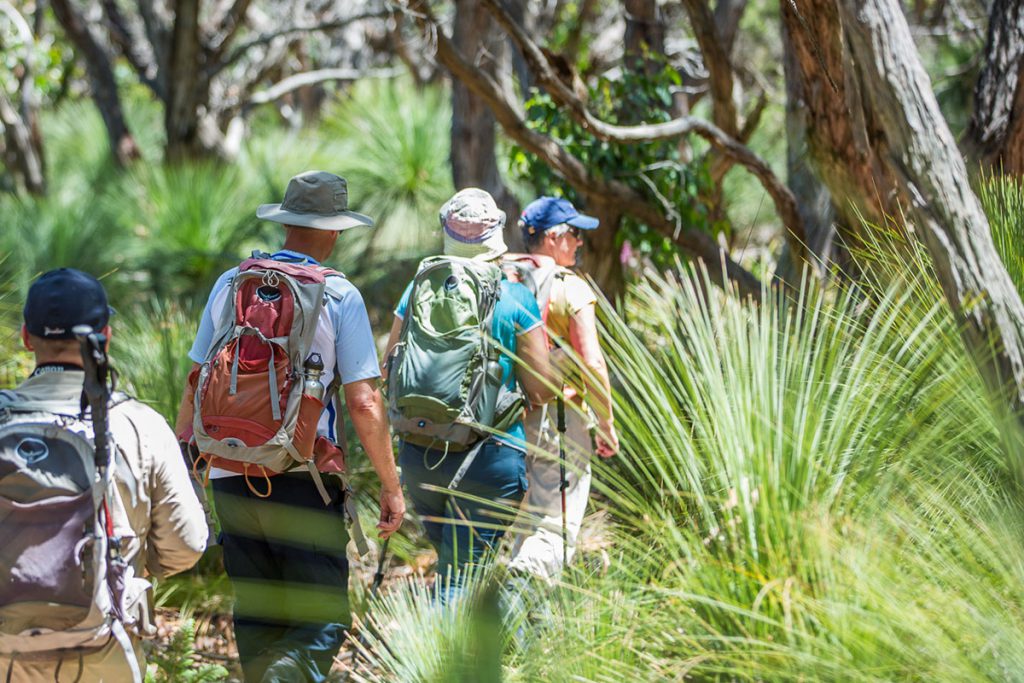
Enjoy a guided walking experience with Great Walks of Australia on the Twelve Apostles Lodge Walk in Victoria.
Want time in nature that clears your head, not a test of endurance? Would you like the beauty and drama of Australian landscapes, with guides who keep you safe, share stories of place, and take care of the details that can make or break a trip? That is exactly what a guided walk with Great Walks of Australia is designed to deliver.
A good guide changes what you see, how you feel, and what you remember long after the trail ends.
Quick summary
- Small groups, usually 10 to 16 guests, create space for genuine connection.
- Many walks are lodge based, and you often carry only a day pack.
- Some love the challenge of packing light and carrying everything.
- Luggage transfers are offered on some walks
- Accommodation ranges from wilderness lodges to eco-camps and lux villas.
- Meals showcase high quality regional produce and incredible Australian hospitality.
- Guides are trained in safety and first aid, with practiced emergency procedures.
- You come for the views and leave with a deeper sense of place.
What you gain with a guide
A landscape looks different when someone who knows it walks beside you. Guides point out details you might miss: a wedge-tailed eagle riding a thermal, a patch of wildflowers thriving after rain, the way a rock shelf tells a story of ancient seas. They know when to pause for a quiet moment and when to push on for a wow view. More than logistics, they bring context that anchors you to the land.
Small groups, big connection
Walking in a small group feels human. With 10 to 16 guests, there is time for easy conversation and long silences without pressure. You might find yourself swapping life stories with a new friend under a sky that looks close enough to touch, then settling into a companionable quiet as your boots settle into a shared rhythm. That sense of belonging often becomes a highlight in itself.
Comfort without losing the wild
This is hiking in comfort. Many walks are lodge based so you carry only a day pack. On some itineraries your luggage is transferred for you. On others you pack light and carry throughout. Some nights you might stay in the same eco-lodge, on other walks you move from camp to camp. Most nights you are treated to a ceiling of stars no matter where you are. You’ll keep the soul of the trail while enjoying the right amount of care.
Safety you do not have to think about
Peace of mind is priceless on remote tracks. Guides prioritise safety with high level first aid training, state-of-the-art equipment, and practiced emergency procedures. You can relax, knowing someone capable is watching weather patterns, track conditions, and group wellbeing, and is ready with a plan if needed.
Food that tells a story
Meals feature high quality regional produce. After a day on the trail, that first bite of house-baked bread or fresh seafood tastes like the landscape itself. Dinner conversations often circle back to where your food came from and the people who grew it. It is more than a meal. It is another way of knowing the place you walked through.
How a typical day feels
- Morning: Wake to the scent of eucalyptus and warm light on your lodge or camp window. Over coffee, your guide outlines the day, the grade, the highlights, and the small moments to look for.
- On trail: Gravel crunches underfoot, the air is cool, and your mind quiets as the landscape opens. Your guide shows you a native plant in flower or points out animal tracks along the path.
- Lunch: Shared on a lookout or beside a creek, simple food tastes amazing in fresh air.
- Afternoon: The track undulates. You fall into an easy pace, led by someone who knows where the shade is and where the views are worth an extra five minutes.
- Evening: A hot shower, a glass of something local, then dinner that celebrates the region. Laughter. Tired legs. A feeling that your whole body has exhaled.
Who these walks suit
- Curious travellers who want meaning with their mileage.
- Couples or friends who appreciate comfort and a little style with their wilderness.
- Solo travellers who want the safety and sociability of a small group.
- Walkers who value knowledgeable guides over going it alone.
Respect for land and culture
Walking with a guide helps you move through landscapes with care. You learn why certain places are significant, how to tread lightly, and how to leave trails as you found them. That respect makes every view feel bigger, because you understand more of what lies beneath it.
Practical details to know
- Group size: Small groups, generally 10 to 16 maximum, keep the experience personal.
- What you carry: Often just a day pack. Or pack light and carry as you move from camp to camp.
- Accommodation style: Ranges from wilderness camps, eco lodges, houseboat or luxury villa, depending on the itinerary.
- Meals: Expect high quality regional produce and generous Australian hospitality.
- Safety: Guides are trained in first aid and carry safety equipment, with clear procedures in place.
How to choose your walk
- Decide your preferred comfort level. Lodge based or swag under the stars.
- Consider how much you want to carry. Day pack only, or personal items in your pack with the rest provided.
- Match the distance and terrain to your fitness and your idea of a good day out.
- Check dates and seasons for the region you want to visit.
- Read about the guides. Their knowledge and style shape your experience.
Frequently asked questions
How fit do I need to be?
Fitness requirements vary by walk. If you are comfortable with several hours on your feet and some uneven terrain, there is likely a walk that fits. Check the grade and daily distances on each walk page.
What will I carry?
On many walks you carry only a day pack. On some, your luggage is transferred. On others, you carry your belongings as you explore the trail and travel to your next overnight camp or lodge. Accommodation is outlined on each itinerary.
Is this a good option for solo travellers?
Yes. Small groups and attentive guides make it easy to feel included, and the social side is as light or lively as you want it to be.
What is included?
Inclusions vary by operator. Commonly, guided walks include accommodation, most meals featuring regional produce, and on-trail support. See the specific walk page for full details.
How big are the groups?
Group sizes are kept small, typically 10 to 16 guests, so guides can personalise the experience and everyone has space to breathe.
Next step ideas
- Browse all walks to compare distances, styles, and landscapes in our planning guide.
- Check upcoming dates and availability for your preferred season here.
- Take onboard operator packing advice in pre-departure materials so you arrive prepared and comfortable.
- Meet our guides and learn more about who they are and their experience.
Important note
Details such as inclusions, pack weight, accommodation style, and group size can vary by operator. Always review the individual walk page before you book.
To take a look through our walks, visit https://greatwalksofaustralia.com.au/our-walks/
